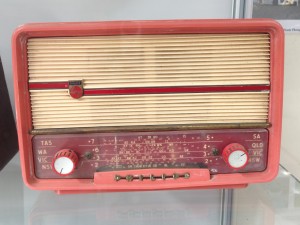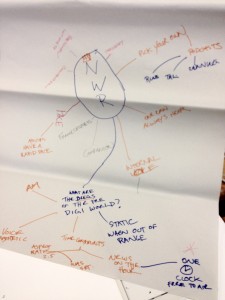COMM2625 MEDIA 2 – Studio Production 11th of September 2015
Daniel Bowden
s3521907
Have you ever wondered what would happen if the yidaki (didgeridoo) had a sonic duel with the soundscape of the city at 131 beats per minute in a 4/4 time signature? Hit PLAY to find out!!
Yidaki Symphony with Kent Morris – CEO of The Torch
This work incorporates the recording of Kent’s yidaki (the traditional name didgeridoo) and clap- sticks recorded on location with a host of other sound textures that were audible at the site of The Morell Bridge. The piece is a representation of how sounds have built up over time at this location, using a push-pull motion that has been influenced by Felix Blume’s oeuvre, most notably in his piece Les Gritos de Mexico (2014).
Yidaki Symphony is about the location of the Morell Bridge. In the field recording, Kent has commented that Birrarung, which is the traditional name of this area, has changed for the worst — yet ultimately, it still holds spiritual power. This piece is entitled Yidaki Symphony, which is a somewhat tongue-in-cheek name that reflects the fact that, in this day and age, the sounds of the city have become those of the traditional corroboree.
The piece represents a tug of war between cultures, new and old, and is structured according to a loose chronological timeline running in reverse from; the city’s overdevelopment, western invasion, people, wildlife and then the river.
It begins with an electrical buzz that pans from left to right which signals industrial development. Although it goes against the chronology of the story, after consulting with my peers, I needed to a) begin the piece less abruptly and b) have something that will grab the listeners intention so to engage them further.
The footsteps are an important feature as they symbolise aboriginal culture striving to readjust to find their place during the insurgence of western domination. The footsteps meander to one side and are then followed with sounds of industry until eventually, they are forced to run. However, as the yidaki pulls focus, as the piece draws to a close, it is to remind us of the continued Aboriginal presence throughout western development.
The bridge itself is the centre of the story of how that part of the river, Birrarung, has changed since colonisation, resonating both aurally and culturally.
The sounds of the clock, jet, birds, traffic, truck, sirens thunder, footsteps, wind, river, pick axe and electricity have been sourced from freesounds.org, Favourite Australian Bird Song CD and my own foley produced in the studio. Kent’s playing of the yidaki was recorded live at Morell Bridge with a Zoom H6 recorder and two Rode condenser microphones, they were treated in postproduction to extend their decay in certain phrases. To heighten the rhythmic element of the piece, I have placed all audio files on a 4/4 time signature grid set to a tempo of 131 BPM.
I’ve always sort honesty and conviction in art, Radio’s New Wave has extended from reporting to just that… art. In order to frame a text in Radio’s New Wave, according to Radiolab’s Jad Abumrad, sounds such as music, foley and the warping of the original are often called upon to sustain an emotive audience. However, a fine balance must be struck when producing nonfiction artefacts, because, such sonic affectations run the risk of being distracting and annoying. They may have an adverse affect to the truth if not used sparingly.
The figure above is the studio in preparation and below, is a look at the packed-to-the-gills Protools session.
_____________ References;
- Adumrad, J R. Krulwich (2007) [PODCAST] Making Radio Lab, RadioLab, WNYC.
- Blume, F. (2014), [PODCAST], Les Gritos de Mexico, France, ArteRadio.
- Skeoch, A & Koschak, S (2001) Favourite Australian Bird Song – Castlemaine Victoria,Listening Earth.
- ACM International Conference on Multimedia (2013), [DATABASE] Freesound TechnicalDemo, Proceedings of the 21st ACM international conference on Multimedia, ACM.

